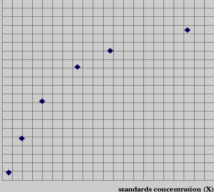CD28
Enzyme linked immunosorbent assay
Analytical reagent
Box instruction manual
This reagent is for research use only
Purpose: This kit is used to determine rat serum, plasma, cell supernatant and related liquid samples.
Rat
CD28
The content.
Experimental principle
:
This kit is determined by double antibody sandwich assay
specimen
in
Rat
CD28
Level. Purified
Rat
CD28
The antibody is coated with a microplate to prepare a solid phase antibody, which is sequentially added to the microwell of the coated monoclonal antibody.
CD28
, and then marked with HRP
CD28
Antibody-antigen-enzyme-labeled antibody complex
After thorough washing
plus
The substrate TMB developed color. TMB is at
HRP
The enzyme is converted to blue by catalysis and converted to the final yellow color by the action of an acid. The depth of the color and the sample
CD28
Positive correlation. Using a microplate reader
450
Absorbance (OD value) is measured at nm wavelength,
Passing the standard curve
Calculating samples
Rat
CD28
concentration.
Kit composition
:
Sample processing and requirements
:
1. Serum: The blood is naturally coagulated at room temperature for 10-20 minutes and centrifuged for about 20 minutes (2000-3000 rpm). The supernatant is carefully collected, and if precipitation occurs during storage, it should be centrifuged again.
2. Plasma: EDTA or sodium citrate should be selected as an anticoagulant according to the requirements of the specimen. After mixing for 10-20 minutes, centrifuge for about 20 minutes (2000-3000 rpm). The supernatant is carefully collected, and if a precipitate forms during storage, it should be centrifuged again.
3. Urine: Collect with a sterile tube and centrifuge for about 20 minutes (2000-3000 rpm). The supernatant is carefully collected, and if a precipitate forms during storage, it should be centrifuged again. The chest and ascites and cerebrospinal fluid are referred to.
4. Cell culture supernatant: When detecting secreted components, collect them with a sterile tube. Centrifuge for about 20 minutes (2000-3000 rpm). Collect the supernatant carefully. When the components in the cells were detected, the cell suspension was diluted with PBS (pH 7.2-7.4), and the cell concentration reached about 1 million/ml. By repeated freezing and thawing, the cells are destroyed and the intracellular components are released. Centrifuge for about 20 minutes (2000-3000 rpm). Collect the supernatant carefully. If a precipitate forms during storage, it should be centrifuged again.
5. Tissue specimen: After cutting the specimen, weigh the weight. Add a certain amount of PBS, pH 7.4. It was quickly frozen and stored in liquid nitrogen for use. The specimen still maintains a temperature of 2-8 ° C after melting. A certain amount of PBS (pH 7.4) was added, and the specimen was homogenized by hand or homogenizer. Centrifuge for about 20 minutes (2000-3000 rpm). Collect the supernatant carefully. One part of the package is to be tested, and the rest is frozen for use.
6. The specimens should be extracted as soon as possible after collection, and the extraction should be carried out according to the relevant literature. The experiment should be carried out as soon as possible after extraction. If the test cannot be performed immediately,
Put the specimen in
-20
°C save, but
should
Avoid repeated freezing and thawing
.
7.
Cannot detect samples containing NaN3
, NaRP3 inhibits horseradish peroxidase (HRP) activity.
Steps:
1.
Dilution and loading of standard products: 10 holes of standard holes are set on the enzyme label coating plate, and standard 100 is added to the first and second holes respectively.
μ
l, then add standard dilution 50 in the first and second holes
μ
l, mix; then take 100 from each of the first hole and the second hole
μ
l are added to the third hole and the fourth hole respectively, and then the standard dilution 50 is added to the third and fourth holes respectively.
μ
l, mix; then take 50 in each of the third hole and the fourth hole
μ
l Discard, then take 50 each
μ
l Add to the fifth and sixth holes respectively, then add 50ul of the standard dilution solution in the fifth and sixth holes, and mix; after mixing, take 50 from each of the fifth and sixth holes.
μ
l Add to the seventh and eighth holes respectively, and add standard dilution 50 to the seventh and eighth holes respectively.
μ
l, after mixing, take 50 from the seventh and eighth holes respectively
μ
l Add to the ninth and tenth holes, and add the standard dilution 50 to the ninth and tenth holes respectively.
μ
l, after mixing, take 50 from each of the ninth and tenth holes
μ
l Discard. (The amount of each well after dilution is 50
μ
l, the concentration is
3
0
Ng/L
,
2
0
Ng/L
,
1
0
Ng/L
,
5
Ng/L
,
2.5
Ng/L).
2.
Adding samples: set blank holes separately (the blank control wells are not added with samples and enzyme-labeled reagents, and the other steps are the same),
Sample hole to be tested
. Add sample dilution 40 to the sample well to be tested on the enzyme coated plate.
μ
l, then add the sample to be tested 10
μ
l (The final dilution of the sample is 5 times).
Add the sample to the bottom of the well of the ELISA plate and try not to touch the hole wall.
lightly
Shake
Mix
.
3.
Incubation: Sealing the plate with a sealing film 37
°C incubation 3
0
minute
.
4.
Solution: 30 (48 times of 20T) concentrated washing solution was diluted with distilled water 30 (20 times of 48T) and used.
5.
Washing: Carefully remove the sealing film and discard the liquid.
Dry
Fill each well with the washing solution, let stand for 30 seconds, then discard it, repeat 5 times, and pat dry.
6.
Add enzyme: add enzyme label reagent 50 per well
μ
l, except for blank holes
.
7.
Incubation: The operation is the same as 3.
8.
Washing: The operation is the same as 5.
9.
Color development: first add color developer A50 to each well
μ
l, then add the developer B50
μ
l, gently shake and mix, 37
°C in the dark for 15 minutes.
10.
Termination: per hole plus termination
50 μl of liquid, stop the reaction
(At this time, the blue turns yellow)
.
11.
Determination: with blank air conditioner zero,
4
50
The nm wavelength measures the pores sequentially
Absorbing light
Degree (OD value)
.
The measurement should be carried out within 15 minutes after the addition of the stop solution.
Precautions:
1.
The kit should be taken out from the refrigerated environment and should be used at room temperature for 15-30 minutes before use. If the enzyme label is unsealed after opening, the slats should be stored in a sealed bag.
2.
Concentrated washing solution
may
There will be
crystallization
Precipitation, warming in a water bath when diluting
, washing does not affect the results.
3.
The sampler should be used for each step, and the accuracy should be corrected frequently to avoid test errors. It is best to control the loading time within 5 minutes. If the number of specimens is large, it is recommended to use a gun.
4.
Please make a standard curve at the same time of each measurement, it is best to make a double hole. If the content of the substance to be tested in the specimen is too high (the OD value of the sample is larger than the OD value of the first hole of the standard well), please first dilute the sample dilution with a certain multiple (n times) before measuring.
Multiply by
Total dilution factor (
×n×5
).
5.
The sealing film is intended for single use only to avoid cross-contamination.
6.
Please keep the substrate away from light.
7.
Strictly follow the instructions of the manual, the test results must be based on the microplate reader reading.
8.
All samples, washings and various wastes should be treated as infectious materials.
9.
The different batch components of this reagent must not be mixed.
10.
If it is different from the English manual, the English manual shall prevail.

Previous:As part of asphalt fatigue testing machine equipment? -Huaqiang Electronic Network
Next: UV-1100 spectrophotometric method for rapid measurement of peroxide content of oxides in edible oils - Master's thesis - Dissertation
Related reading EL
- • [Technical Information] Hongli and Japan OKI expand cooperation 0.22 micron flash memory process for fingerprint authentication accelerator 2016-08-10 14:18
- • [Technical Information] Chartered Acquires Hitachi Singapore Fab to Expand Capacity Expansion Business 2016-08-10 14:18
- • [Technical Information] SanDisk and Toshiba release 41% increase in integration of 3bit NAND flash technology per unit 2016-08-10 14:18
- • [Technical Information] Hitachi and Renesas develop new technology system LSI on-chip SRAM power consumption reduction of 40% 2016-08-10 14:18
- • [Technical Information] Sharp Alliance Tokyo Electronics enters the solar cell equipment market 2016-08-10 14:18
- • [Technical Information] In 2007, the top ten units of China's electronic special equipment industry were released 2016-08-10 14:18
- • [Technical Information] Tianwei Baole Leshan Power and US Company Signed 40 Million Euros to Order Polysilicon Equipment 2016-08-10 14:18
- • [Technical Information] Dow Corning Silicon Polymer Resin Capability Doubles More Manufacturers Benefit from Advanced Photoresist 2016-08-10 14:18
SHENZHEN CHONDEKUAI TECHNOLOGY CO.LTD , https://www.szfourinone.com
